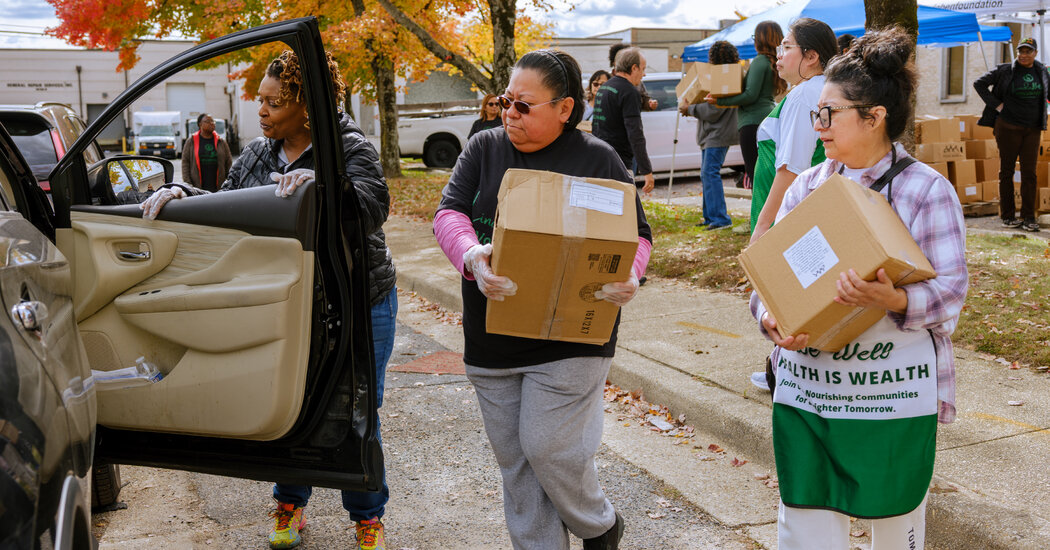Food banks across the United States were stretched thin even before the federal government shut down. Rising food prices had driven a growing number of people to their doors. Cuts to federal programs had left them with less to give.
Now, that system — a last resort for tens of millions of hungry Americans — is anticipating an even greater surge in demand.
With no end in sight to the nearly monthlong federal government shutdown, funding for the nation’s largest food assistance program, known as SNAP, will disappear at the start of November, according to the Department of Agriculture. On Friday, the Trump administration said in a memo that it would not tap into contingency funds to keep payments flowing to states.
That means that the roughly 42 million Americans who rely on SNAP — the Supplemental Nutrition Assistance Program — may soon have to find other ways to feed themselves and their families.
Many of them will turn to local food pantries. Anti-hunger organizations and food banks say the surging demand will almost certainly exceed their capacity to respond. And the impact could resonate well beyond the shutdown.
“When that social safety net breaks above us, we will be there to do as much as we can,” said Andrea Williams, president of the Oregon Food Bank, which helps supply food to roughly 1,200 pantries and meal sites across Oregon and southwest Washington. “And it will not be enough.”
There are more than 47 million Americans who, at some point during the year, face food insecurity — meaning they do not have enough to eat and do not know where their next meal will come from — according to the Agriculture Department’s latest report. There are millions more who don’t fully fit that definition but nonetheless turn to charitable food programs for support, according to Feeding America, a nationwide network of food banks, food pantries and local meal programs.
Since the pandemic, a steady drumbeat of inflation has substantially increased prices at the grocery store, driving more people of limited means to food banks.
Visits to Ms. Williams’ network of food pantries in Oregon are up 50 percent over the last two years alone, she said. Radha Muthiah, the head of Capital Area Food Bank, which serves Washington D.C. and surrounding counties in Virginia and Maryland, said visits to pantries in her service area have doubled since before the pandemic.
But earlier this year, the Trump administration cut nearly $1 billion in federal aid for anti-hunger programs, including one that supplies food directly to food banks. At distribution sites in New Orleans and Detroit on Saturday, volunteers described the situation in simple terms.
“Demand is up, food is down,” said John Sillars, who helps run the Second Harvest Food Bank, a regional agency that supplies food pantries across southern Louisiana.
Several food bank directors who were interviewed cited the same statistic: For every nine meals that were supplied by federal food assistance, food pantries can provide only one on their own. No matter how thin they stretch their resources, they will not be able to fill the gap if funding for SNAP does not come through.
“It means people will go hungry, and in particular, kids and seniors and rural communities,” Ms. Williams said.
In previous federal shutdowns, the outlook did not seem quite as grim, said Jill Dixon, director of the Food Depot, which serves nine counties in northern New Mexico, the state with the highest proportion of SNAP recipients among its residents.
In those shutdowns, Ms. Dixon said, there was always the expectation that the federal government would step in to protect SNAP if monthly payments were at stake. Now that’s not the case.
She compared the scale of the need for food assistance that her organization is anticipating to the early days of the pandemic, when business closures and mass layoffs sent a multitude of Americans scrambling.
“I think it has the potential to be bigger than that,” Ms. Dixon said.
Some states have taken emergency financial measures to keep aid flowing to SNAP recipients, while other states search for answers.
Gov. Glenn Youngkin of Virginia, a Republican, declared a state of emergency in anticipation of the cutoff. Gov. Gavin Newsom of California announced plans to call up the National Guard to support food banks. And in Louisiana, where 18 percent of the population relies on SNAP — the second highest proportion after New Mexico — lawmakers are expected to approve using reserve funds temporarily to cover missing payments.
The situation may be dire in areas with large populations of federal workers, Ms. Muthiah said. The Trump administration’s slashing of the federal work force earlier this year had already driven up food insecurity in those areas; then the shutdown cut off paychecks for most of those who still had government jobs.
Now, Ms. Muthiah said she expects to see the long lines for food grow even longer, and pantries that were already running low may have to turn even more people away.
“This could be just an inordinate number of people,” she said.
Cars lined up for blocks in Beltsville, Md., on Saturday, waiting at one of several food distribution events that Ms. Muthiah’s network has held for federal employees who have gone weeks without wages.
After 45 minutes and 320 boxes given away, the Beltsville site ran out of food, and everyone who was still in line had. to drive away empty-handed. The same thing happened a day earlier at another distribution event.
“To see all these federal employees have to do this — it breaks my heart,” said Maria Staunton, 46, a volunteer at the Beltsville site who had been furloughed from a position as an auditor. “With a federal job, it used to be that you didn’t have to worry. It used to be a very stable job.”
JoAnna Daemmrich, Katy Reckdahl, and Ryan Patrick Hooper contributed reporting.
Chris Hippensteel is a reporter covering breaking news and a member of the 2025-26 Times Fellowship class, a program for journalists early in their careers.
The post Food Banks Brace for Overwhelming Demand as SNAP Cutoff Looms appeared first on New York Times.




